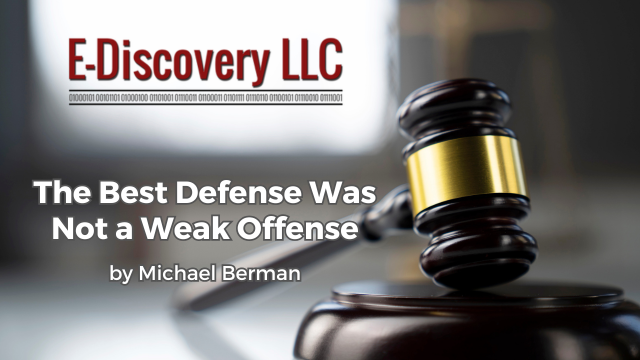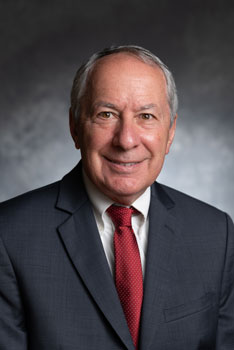
[EDRM Editor’s Note: The opinions and positions are those of Michael Berman.]
Plaintiff’s offensive motion for sanctions in Oakley v. MSG Networks, Inc., 2025 WL 2076080, at *1 (S.D.N.Y. July 23, 2025)(“Oakley II”), was no match for defendants’ earlier request for sanctions in Oakley v. MSG Networks, Inc., 2025 WL 2061665, at *1 (S.D.N.Y. July 23, 2025)(“Oakley I”).
In Oakley I, defendants (“MSG”) made the first request for sanctions. In Oakley II, in the court’s words, “the day before [defendant] MSG was scheduled to submit its spoliation motion – [plaintiff] Oakley submitted a letter to the Court requesting a pre-motion conference regarding his intention to file his own motion for spoliation sanctions against MSG.” Oakley II at *1.
The factual predicate arose out of a disputed ejection of a fan from a ball game:
Oakley, a former star power-forward for the New York Knicks, attended a Knicks game at Madison Square Garden on February 8, 2017…. During the game, Oakley was approached by MSG security guards and New York City Police Department officers, who physically removed him from the arena, purportedly because of his inappropriate behavior.
Oakley I at * 1.
Mr. Oakley asserted that excessive force was used. “Oakley submitted a sworn declaration in which he stated that he was grabbed by MSG security personnel without provocation, pushed to the ground, and ultimately dragged out of Madison Square Garden.” Id. (cleaned up).
The National Basketball Association reported that:
Former Knicks star Charles Oakley was forcefully removed from his seats at Madison Square Garden and arrested after an altercation near team owner James Dolan.
Oakley shoved security guards before they pulled him away from his seat behind the baseline during the first quarter of the Knicks’ 119-115 loss to the Los Angeles Clippers on Wednesday night. Fans chanted “Oakley! Oakley!” in support of the popular power forward.
B Mahoney, Associated Press, Former Knick Oakley ejected after altercation in MSG seats | NBA.com (Feb. 8, 2017).
“The NYPD said Oakley was arrested on three counts of assault, all third degree.” Id. This blog addresses the civil lawsuit arising from the February 2017 incident.
OAKLEY I
Facts
The court held that: “Oakley had a duty – at the latest – from September 12, 2017 onwards to preserve any text messages pertaining to his removal from MSG.” Id. at *4.
However, plaintiff, Mr. Oakley, took no steps to preserve any potentially discoverable materials on his cell phone. Oakley I at *1. He said that his phone broke and he upgraded to a new one. The court wrote:
He did not image his [old] phone, nor did he back up his phone to a cloud-based storage service…. In Oakley’s own words, “[i]t was more important to have a [new] phone” than it was to preserve the data saved on his device.
Id.
Mr. Oakley’s counsel discovered that all text messages prior to February 2022 had been destroyed. Counsel commendably1 disclosed this to counsel for MSG. MSG stated its intent to move for sanctions.
A few days later, Mr. Oakley was deposed. He said that he upgraded because his phone broke. He testified that he does not “text a lot” and said that he gets approximately six or seven texts per day. He admitted that he took no steps to preserve the data on the phone.
At a pre-motion conference, Mr. Oakley reiterated that he does not text a lot. The court wrote that: “In contrast to his deposition testimony, Oakley explained that he traded in his phone three times during the past eight years, including once in 2021.” It added: “Oakley further acknowledged that he knew he had a duty to preserve documents, including text messages, for this litigation.”
In contrast to his deposition testimony, Oakley explained that he traded in his phone three times during the past eight years, including once in 2021… Oakley further acknowledged that he knew he had a duty to preserve documents, including text messages, for this litigation.
Oakley v. MSG Networks, Inc., 2025 WL 2061665 (S.D.N.Y. July 23, 2025)(“Oakley I”).
MSG moved for sanctions. It also prudently obtained metrics to support that motion: “While that motion was pending, MSG received returns from its subpoena to AT&T, which included 10,200 pages of records containing the metadata – but not the content – of Oakley’s text messages.”
This type of metadata cross-check can be very useful. The cross-check data did two things. First, it showed that Mr. Oakley had upgraded his phone more often than he testified. Second, it provided metrics as to how often he texted. According to the court, both raised credibility issues.
Fed.R.Civ.P. 37(e) Analysis
It was essentially undisputed that Mr. Oakley’s duty to preserve was triggered, at the latest, in September 2017, long before the cell phone upgrade.
The court next looked to whether Mr. Oakley had taken reasonable preservation steps. His attorneys had included a “hold notice” in their retainer letters.
However, the reasonableness issue was resolved in a battle of experts. Philip Favro, Esq., of Favro Law PLLC, was the expert for MSG and “[a]fter carefully reviewing both expert reports, the Court finds Mr. Favro’s report and analysis to be more persuasive by a wide margin.” Id. at *5.
Phil defined reasonable steps. “Rule 37(e) does not call for perfection.” Id.2 Phil concluded that neither Mr. Oakley nor his counsel took reasonable preservation steps. His report pointed out that the phone could have been imaged for approximately $500. And, it pointed to other possible preservation options, none of which were taken. Id. The court wrote:
And while Oakley makes much of the fact that the core allegations in this case do not pertain to his text messages, Mr. Favro made clear that “in 2017 (and earlier)[,] lawyers would often image clients’ cell phones to ensure that relevant data was preserved,” “even in cases that were not focused on issues surrounding text message communications.”
Id.
Phil also opined that the single paragraph in the retainer agreement was insufficient to impose a legal hold. He explained that “[c]ounsel must take actual, actionable steps to make sure evidence is retained and to avoid the possibility of deletion of relevant evidence.” Id. at *6. The court found that neither Mr. Oakley nor his attorneys took reasonable steps to preserve the ESI.
The court then looked to see if secondary evidence was available. Subpoenas to numerous people failed to fill the gap caused by Mr. Oakley’s failure to preserve his cell phone ESI. Id. at *6. It explained:
Turning to subsection (e)(1), the court found that MSG “amply demonstrated” prejudice. Both parties agree that Oakley sent at least 826 text messages in the three weeks following his removal from MSG, which amounts to an approximate average of thirty-nine text messages per day…. In fact, Oakley sent at least sixty-four text messages in the first twenty-four hours following his removal and forty more messages over the course of the next day…. The AT&T records further revealed that the average number of text messages that Oakley sent increased over 250% in the three-week period following his removal as compared to the days leading up to the incident…. This increase was even more pronounced during the first full day after the incident, which supports the inference that Oakley sent text messages related to the claims at the heart of this case…. Indeed, Oakley himself ultimately admitted that he texted about his removal and specifically identified at least thirteen individuals with whom he texted about the incident.
Id. at *7.
The value of the cross-check evidence is self-evident: “And even if none of Oakley’s text messages pertained to what occurred on the evening of February 8, 2017, MSG has, at the very least, been deprived of the opportunity to argue that Oakley’s failure to discuss an assault in the over 800 text messages that he sent following his removal supports the inference that no such assault occurred. Id.
And even if none of Oakley’s text messages pertained to what occurred on the evening of February 8, 2017, MSG has, at the very least, been deprived of the opportunity to argue that Oakley’s failure to discuss an assault in the over 800 text messages that he sent following his removal supports the inference that no such assault occurred.
Oakley v. MSG Networks, Inc., 2025 WL 2061665, at *7 (S.D.N.Y. July 23, 2025)(“Oakley I”).
The court then crafted a curative sanction under Rule 37(e)(1):
MSG requests permission to present evidence related to Oakley’s failure to preserve his text messages. The Court agrees that this remedy, which is explicitly contemplated in the Advisory Committee’s Note, is appropriate here…. Indeed, courts in this District regularly allow the disadvantaged party to put on evidence related to the loss of ESI.
Id. at *8.
It also awarded attorneys’ fees against Mr. Oakley under that subsection.3
The court then turned to Rule 37(e)(2). “The Court concludes that MSG has established by a preponderance of the evidence that Oakley acted with the intent to deprive MSG of his text messages in this litigation.” As an initial matter, it wrote that Oakley’s intent can be inferred from “his significant failure to preserve his text messages.” It noted that Mr. Oakley even admitted that he knew some data would be lost in the upgrade. However, the court wrote, Mr. Oakley simply felt it was “[m]ore important for me to have a phone.” In short, the court determined that Mr. Oakley knew he had a preservation duty and breached it. Id. at *9.
The court continued, writing that: “Oakley has repeatedly argued that he lost his text messages because his phone broke and he had no choice but to upgrade to a new device.…” The court said that this explanation “is simply not credible” in light of contradictory cross-check records. Id. at *10.
Finding “a broader pattern of Oakley making sworn statements to the Court that are then contradicted by subsequently unearthed evidence,” the court decided to grant an adverse inference instruction. Id. at *11-12.4
OAKLEY II
Faced with MSG’s sanctions proposal, Oakley decided to fight fire with fire. “[T]he day before MSG was scheduled to submit its spoliation motion – Oakley submitted a letter to the Court requesting a pre-motion conference regarding his intention to file his own motion for spoliation sanctions against MSG.” 2025 WL 2076080, at *1. Mr. Oakley “alleged spoliation of corporate emails, two corporate cellphones of MSG security personnel, and a binder containing material used to prepare MSG Chief Executive Officer James Dolan for a televised interview.” His motion was denied. Oakley II, at *1.
Emails and Technical Glitch
In addition to sending legal hold notices and reminders, “MSG implemented a technical legal hold through Microsoft’s Purview software, which was designed to ensure that emails are retained no matter what the user does and bypass or override the retention settings of the organization so that emails are not automatically deleted.” Id. at *4 (cleaned up).
However, Purview did not work:
Despite these efforts, MSG discovered in the summer of 2024 that the Custodians’ emails were missing…. In response, MSG undertook “enormous efforts” and “conducted an exhaustive investigation to try to locate” the lost emails…. MSG ran multiple searches to determine if the lost emails could be found elsewhere in its systems or in another user’s mailbox…. MSG also “located physical servers” and “prior endpoints, computers, [and] phones[ ] that would have potentially been issued to” the Custodians to determine if the emails still existed on those devices…. When these efforts were unsuccessful, MSG retained Joseph Pochron – Managing Director for Digital Investigations and Cyber Risk at the expert forensics firm Nardello & Co. – to determine whether any of the lost emails could be recovered and then to investigate how and why the emails were lost…. Pochron and his team ultimately could not locate the missing emails but concluded that “MSG experienced a systemic technical glitch or error that occurred in their Microsoft … environment that impacted a legal hold in this case, amongst others.”
Id. (cleaned up; links added).
Despite arguments to the contrary, the court credited this explanation of a technical malfunction. Therefore “spoliation sanctions clearly are not warranted here.” Id. at *5.
For a historical perspective on software “glitches,” please see What Does “The Making of a Surgeon” Have to Do With ESI and “Software Glitches?” (Jul. 15, 2011). That blog discusses some non-litigation and litigation-related software glitches.
Corporate Cell Phones
Mr. Oakley sought sanctions for failure to preserve certain cell phones. However, the court had repeatedly ruled that MSG’s duty to produce did not include text messages.
The court explained: “That is because Oakley had only requested that MSG produce corporate emails in his original motion to compel document production from MSG.” This illustrates the settled principle that If You Don’t Ask the Right Question, You Won’t Get the Answer (Feb. 8, 2025).
Alternatively, the court held that Mr. Oakley could not show prejudice. The two cell phones users submitted affidavits that they did not recall sending or receiving any texts about the incident.5
The Paper Binder
Mr. Oakley’s motion for spoliation of a paper binder failed in large part because MSG “repeatedly made clear” that “all documents that were in the binder relating to [Oakley’s removal] were produced individually, just not in binder format,” and it identified those documents by their Bates numbers. Id. at *6.
One takeaway from Oakley I is the solid use of metrics. Another is the use of a sophisticated ESI expert who was credited over an expert with lesser ESI credentials. The best defense is a good defense.
Notes
- See Is There a Duty to “’Fess Up?” – Part II (Nov. 12, 2022); Candor Pays Off When It Comes to Alleged Spoliation: Notice + Accrual = Claims Bar (Apr. 6, 2023). ↩︎
- See What Does “The Making of a Surgeon” Have to Do With ESI and “Software Glitches?” (Jul. 15, 2011); StubHub: Modification of ESI Protocol and Denial of Sanctions – Performance Was Impossible (May 23, 2024). ↩︎
- For a discussion of awarding monetary sanctions under Rule 37(e)(1), see 7th Circuit Affirms Dismissal and Monetary Sanctions Against Both Attorney and Client (Aug. 6, 2025)(novel issue in 7th Cir.). ↩︎
- For more information on Rule 37(e), see Recent “Textbook” Analysis of Fed.R.Civ.P. 37(e) (Apr. 17, 2023). ↩︎
- Cf. Trust Me: Nothing in the Missing Video Would Have Helped You! (Sep. 10, 2024). ↩︎
Assisted by GAI and LLM Technologies per EDRM GAI and LLM Policy.


